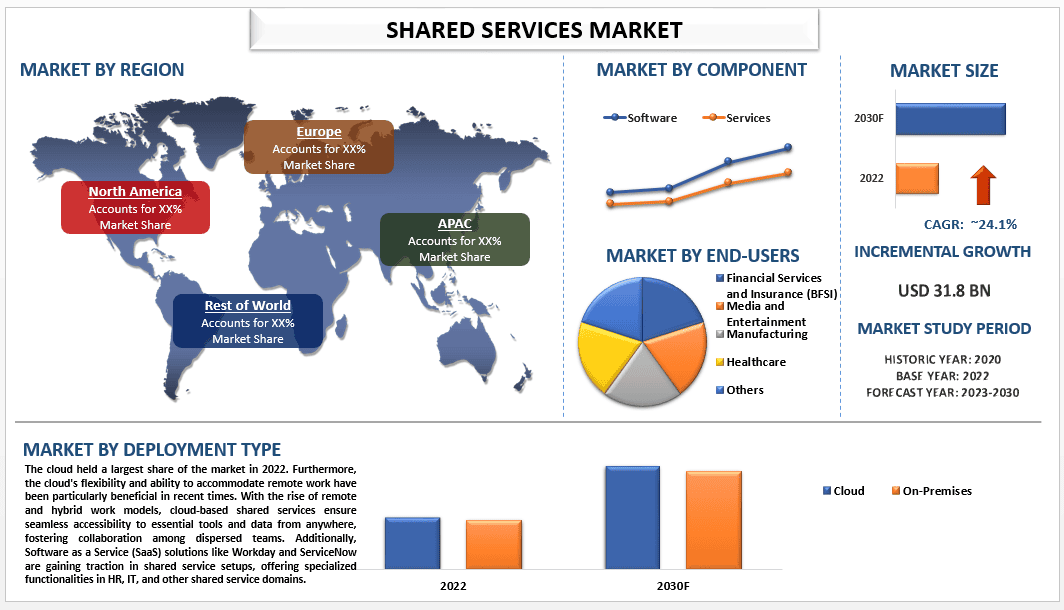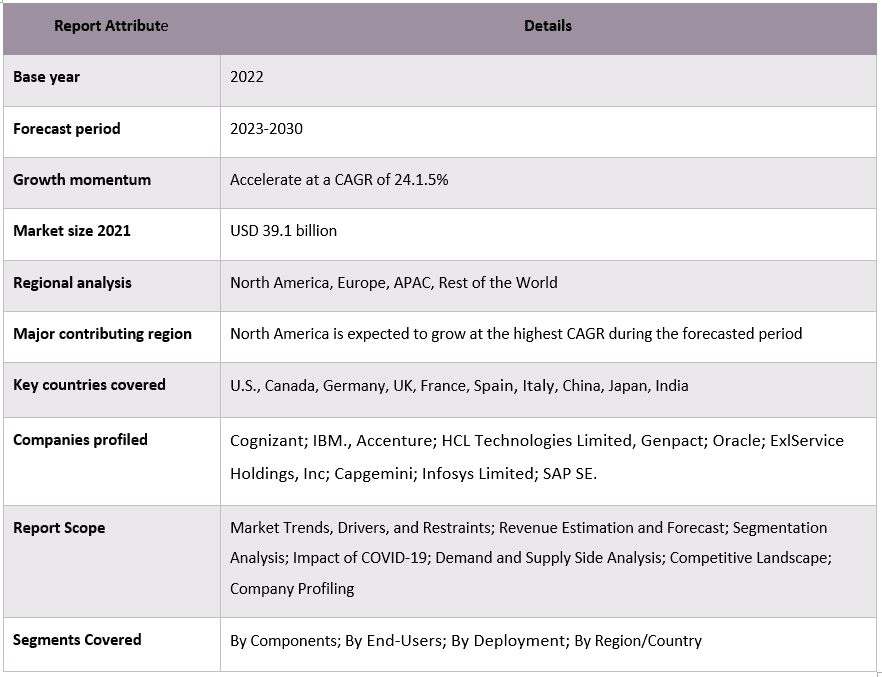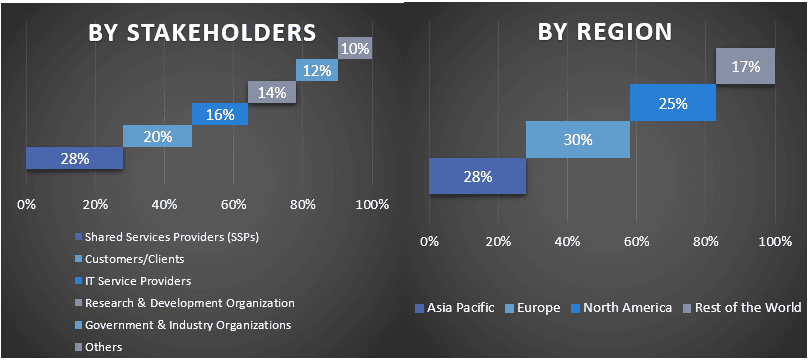- Home
- About Us
- Industry
- Services
- Reading
- Contact Us
Shared Services Market: Current Analysis and Forecast (2023-2030)
Emphasis on component (Software and Services); End-Users (Banking Financial Services and Insurance (BFSI), Media and Entertainment, Manufacturing, Healthcare, and Others); End-Use (Cloyd, and On-Premises); and Region/Country

The shared services market was valued at USD 31.8 Billion in the year 2022 and is expected to grow at a strong CAGR of around 24.1% during the forecast period. Globally, the adoption of shared services continues to escalate across industries and geographies, driven by the pursuit of operational efficiency, cost optimization, and enhanced service delivery. Organizations worldwide are recognizing the transformative potential of shared services in streamlining processes, consolidating operations, and leveraging economies of scale. This global surge is fueled by advancements in technology, particularly the advent of cloud computing, automation, and data analytics, enabling shared service centers to transcend geographical boundaries and operate seamlessly across diverse regions. Moreover, the COVID-19 pandemic has accelerated the adoption of shared services as companies pivoted towards remote work, prompting a reevaluation of operational models and a greater reliance on digital solutions.
Some of the major players operating in the market include Cognizant; IBM., Accenture; HCL Technologies Limited, Genpact; Oracle; ExlService Holdings, Inc; Capgemini; Infosys Limited; SAP SE. Several M&As along with partnerships have been undertaken by these players to facilitate customers with hi-tech and innovative products/technologies.
Insights Presented in the Report
“Based on components, the market is segmented into software and services. Among them, the services segment held a considerable share of the market in 2022.”
Based on components, the market is segmented into software and services. The services segment has highest market share and is expected to dominate during forecast period, driven by the quest for streamlined operations and cost efficiency. One significant trend contributing to this growth is the expanding global footprint of companies. With businesses spanning diverse geographies, the need for software and services capable of multilingual support becomes imperative. Companies are increasingly investing in services tailored to specific languages, such as customer support, translation services, and multilingual content creation.
“Based on End-Users, the market is segmented into BFSI, media and entertainment, manufacturing, healthcare and others (utility, consumer goods, and education). Among them, BFSI segment held a considerable share of the market in 2022.”
Based on End-Users, the market is segmented into BFSI, media and entertainment, manufacturing, healthcare and others(utility, consumer goods, and education). The BFSI sector dominates with a highest share of the market. In the BFSI sector, companies are leveraging shared services to centralize back-office functions like accounting, compliance, and customer support. By consolidating these operations, financial institutions achieve cost efficiencies, standardize processes, and enhance their ability to navigate regulatory complexities. Shared services enable BFSI organizations to optimize resources, improve service delivery, and redirect focus toward innovation and client-centric initiatives.
Shared Services Market Report Coverage

“North America hold the highest share of the shared services market in 2022.”
North America will hold the largest share of the market in 2022. North America serves as a hub for shared services evolution, with corporations across diverse industries actively integrating these models into their operational frameworks. The region’s dynamic business landscape has fostered the widespread adoption of shared services. Various industries, including finance, healthcare, technology, telecommunications, and manufacturing, have embraced shared services as a means to streamline operations, optimize resources, and enhance service delivery. The collaborative nature of shared services has revolutionized how North American businesses operate, enabling them to consolidate resources, standardize processes, and focus on core competencies, enhancing competitiveness in both domestic and global markets. For instance, in 2023, TD Bank Group (TD) reaffirms its commitment to strengthening its technology workforce by tapping into relationships with key recruitment and tech talent organizations, such as Black Professionals in Tech Network (BPTN) and FDM Group, to continue to help build a strong pipeline of diverse talent and new colleagues.
Reasons to buy this report:
- The study includes market sizing and forecasting analysis validated by authenticated key industry experts.
- The report presents a quick review of overall industry performance at one glance.
- The report covers an in-depth analysis of prominent industry peers with a primary focus on key business financials, product portfolios, expansion strategies, and recent developments.
- Detailed examination of drivers, restraints, key trends, and opportunities prevailing in the industry.
- The study comprehensively covers the market across different segments.
- Deep dive regional level analysis of the industry.
Customization Options:
The global shared services market can further be customized as per the requirement or any other market segment. Besides this, UMI understands that you may have your own business needs, hence feel free to contact us to get a report that completely suits your requirements.
Table of Content
Research Methodology for the Shared Services Market Analysis (2022-2030)
Analyzing the historical market, estimating the current market, and forecasting the future market of the global shared services market were the three major steps undertaken to create and analyze the adoption of shared services in major regions globally. Exhaustive secondary research was conducted to collect the historical market numbers and estimate the current market size. Secondly, to validate these insights, numerous findings and assumptions were taken into consideration. Moreover, exhaustive primary interviews were also conducted, with industry experts across the value chain of the global shared services market. Post assumption and validation of market numbers through primary interviews, we employed a top-down/bottom-up approach to forecasting the complete market size. Thereafter, market breakdown and data triangulation methods were adopted to estimate and analyze the market size of segments and sub-segments of the industry pertains to. Detailed methodology is explained below:
Analysis of Historical Market Size
Step 1: In-Depth Study of Secondary Sources:
Detail secondary study was conducted to obtain the historical market size of the shared services market through company internal sources such as annual reports & financial statements, performance presentations, press releases, etc., and external sources including journals, news & articles, government publications, competitor publications, sector reports, third-party database, and other credible publications.
Step 2: Market Segmentation:
After obtaining the historical market size of the shared services market, we conducted a detailed secondary analysis to gather historical market insights and share for different segments & sub-segments for major regions. Major segments are included in the report by components, end-users, and deployment. Further country-level analyses were conducted to evaluate the overall adoption of testing models in that region.
Step 3: Factor Analysis:
After acquiring the historical market size of different segments and sub-segments, we conducted a detailed factor analysis to estimate the current market size of the shared services market. Further, we conducted factor analysis using dependent and independent variables such as components, end-users, and deployment of the shared services market. A thorough analysis was conducted of demand and supply-side scenarios considering top partnerships, mergers and acquisitions, business expansion, and product launches in the shared services market sector across the globe.
Current Market Size Estimate & Forecast
Current Market Sizing: Based on actionable insights from the above 3 steps, we arrived at the current market size, key players in the global shared services market, and market shares of the segments. All the required percentage shares split, and market breakdowns were determined using the above-mentioned secondary approach and were verified through primary interviews.
Estimation & Forecasting: For market estimation and forecast, weights were assigned to different factors including drivers & trends, restraints, and opportunities available for the stakeholders. After analyzing these factors, relevant forecasting techniques i.e., the top-down/bottom-up approach were applied to arrive at the market forecast for 2030 for different segments and sub-segments across the major markets globally. The research methodology adopted to estimate the market size encompasses:
- The industry’s market size, in terms of revenue (USD) and the adoption rate of the shared services market across the major markets domestically
- All percentage shares, splits, and breakdowns of market segments and sub-segments
- Key players in the global shared services market in terms of products offered. Also, the growth strategies adopted by these players to compete in the fast-growing market
Market Size and Share Validation
Primary Research: In-depth interviews were conducted with the Key Opinion Leaders (KOLs) including Top Level Executives (CXO/VPs, Sales Head, Marketing Head, Operational Head, Regional Head, Country Head, etc.) across major regions. Primary research findings were then summarized, and statistical analysis was performed to prove the stated hypothesis. Inputs from primary research were consolidated with secondary findings, hence turning information into actionable insights.
Split of Primary Participants in Different Regions

Market Engineering
The data triangulation technique was employed to complete the overall market estimation and to arrive at precise statistical numbers for each segment and sub-segment of the global shared services market. data was split into several segments & sub-segments post studying various parameters and trends in the areas of the components, end-users, and deployment in the global shared services market.
The main Objective of the Global Shared Services Market Study
The current & future market trends of the global shared services market were pinpointed in the study. Investors can gain strategic insights to base their discretion for investments on the qualitative and quantitative analysis performed in the study. Current and future market trends determined the overall attractiveness of the market at a regional level, providing a platform for the industrial participant to exploit the untapped market to benefit from a first-mover advantage. Other quantitative goals of the studies include:
- Analyze the current and forecast market size of the shared services market in terms of value (USD). Also, analyze the current and forecast market size of different segments and sub-segments.
- Segments in the study include areas of the components, end-users, and deployment.
- Define and analysis of the regulatory framework for the shared services industry.
- Analyze the value chain involved with the presence of various intermediaries, along with analyzing customer and competitor behaviors of the industry.
- Analyze the current and forecast market size of the shared services market for the major region.
- Major countries of regions studied in the report include Asia Pacific, Europe, North America, and the Rest of the World
- Company profiles of the shared services market and the growth strategies adopted by the market players to sustain in the fast-growing market.
- Deep dive regional level analysis of the industry
Frequently Asked Questions FAQs
Q1: What is the current market size and growth potential of the Global Shared Services Market?
Q2: What are the driving factors for the growth of the global shared services Market?
Q3: Which segment has the largest share of the global shared services market by component?
Q5: Which country will dominate the global shared services market?
Q6: Who are the key players operating in the global shared services market?
Related Reports
Customers who bought this item also bought










